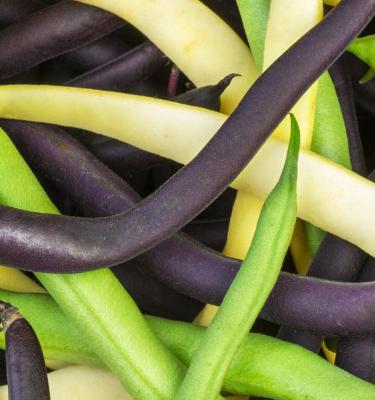

How to grow & care for beans
Beans are a bountiful plant to have in your vegetable garden, they are easy to grow and heavy croppers. You can find beans with climbing or bush growth habits - making them suitable for all garden types, including small spaces and pots.
Beans pods come in green, yellow, purple and even speckled colours and beans are generally grown as either a straight bean to be eaten whole (pod and all) or podding beans, whose outer shell is removed and the seeds (beans) inside the pod eaten.
In the warmer areas of Australia, beans can be grown year-round. While in the temperate and cooler regions it’s best to grow beans throughout spring and summer.
Top 4 steps to growing beans
- Choose a full sun position in your garden or grow in pots.
- Climbing beans will need a support structure or trellis to grow up.
- Improve the soil before planting by adding Scotts Performance Naturals™ Organic Based Soil Improver and Scotts Performance Naturals™ All Purpose Organic Based Fertiliser
- Protect bean seedlings from pests like snails and slugs
Shopping List
- Bean seeds or seedlings
- Scotts Performance Naturals™ Organic Based Soil Improver
- Scotts Performance Naturals™ All Purpose Organic Based Fertiliser
- If growing in pots, Scotts Performance Naturals™ Premium Organic Based Potting Mix
- Garden trowel
- Trellis or support structures for climbing beans
- Defender™ Snail & Slug Pellets
Prepare
Bean can be grown from seeds or seedlings, in a full sun spot. Beans are best grown in a soil enriched with Scotts Performance Naturals™ Organic Based Soil Improver and Scotts Performance Naturals™ All Purpose Organic Based Fertiliser - dig these through the top 10-15cm of soil before planting.
In the warm regions, beans can be grown year-round, while in cold areas it’s best to grow beans in the frost-free seasons of spring and summer.
If you’re growing climbing beans set up the trellis or support structure - set it up before planting to avoid disturbing the beans roots later on. Some climbing beans can grow up to 2 metres tall, so check the label to make sure your support structure is tall enough.
Planting in the garden
Plant beans about 15-20cm apart, with 30-40cm between rows - allow a larger spacing if you live in a particularly humid climate, this will allow better airflow around the plants and help prevent fungal diseases. Protect small seedlings from slugs and snails using Defender™ Snail & Slug Pellets.
Lightly mulch the soil around plants after planting with organic sugar cane to retain moisture.
Growing from seeds
Directly sow bean seeds 2-3cm deep, in rows 30-40cm apart into your prepared garden beds or Scotts Performance Naturals™ Premium Organic Based Potting Mix if growing in pots.
Keep the soil moist, but not soggy while the bean seeds germinate which will take 8-10 days.
Mulch around seedlings when they are 5-10cm tall to retain moisture and protect young seedlings from slugs and snails with Defender™ Snail & Slug Pellets.
Planting in pots
Beans can be grown in medium to large pots that are 30-40cm deep. Fill the pot with Scotts Performance Naturals™ Premium Organic Based Potting Mix and install a support trellis if growing climbing beans. At the base of the trellis sow seeds or seedlings at the recommended spacings as per the label.
Bush beans are brilliant in pots, they can be planted more closely together than climbing beans and as they are self-supporting, they won’t need a trellis. If you’re short on space or growing in pots - look out for bush bean varieties.
Protect young seedlings as they sprout from slugs and snails with Defender™ Snail & Slug Pellets.
Harvest
Your beans will be ready to begin harvesting 10-14 weeks after planting - bush beans are typically faster to crop than climbing varieties. Harvest beans that you plan to eat whole when the pods are crisp and tender - the beans or seeds inside the pods will either not be visible or they’ll be so tiny, they are tender and nice to eat.
Regularly picking beans every 3-4 days will encourage more flowers and a bigger, longer bean harvest.
If beans are left too long before harvesting the pods will become tough. This is fine if you want to consume the beans in the pods or plan to dry the beans out for storage.
.jpg)
Pests & Diseases
Slugs and Snails will cause significant damage to young bean seedlings. Protect your bean crop by setting beer traps (saucers filled with beer) or use Defender™ Snail & Slug Pellets.
To reduce the chance of fungal disease infecting bean foliage, avoid overhead watering and if you live in a region with high humidity make sure there is plenty of airflow between plants.



